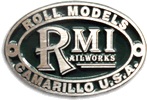- We would like to talk to you about a flange standard for 2.5 & 3-3/4 scale equipment on 7.5 & 7.1/4 gauge track. As you may know, RMI Railworks is the largest manufacturer of 2.5" & 3.75" scale railroad equipment in the world. We have developed and tested a flange that is compatible with railroads built to IBLS standards. The RMI-25 flange design has proven itself with many of the modelers in 2.5 and 3-3/4 scale. A few of the other manufacturers are currently, or will be offering this flange as it has proven to be superior for larger equipment.
- Attached is a specification sheet on the RMI-25 flange. We call this flange RMI-25 for two reasons, one it is a .25 tall flange and two, it was designed for 2.5 scale. But as time passes, the .25 tall will be the main definition, as it is used on the above scales. It could also be used on 1.5 and 1.6 without any problem.
- * RMI-25 Wheel Specification

- Question - Since the flange is much larger than the standard 7.5/7.25 inch gauge flange, how does that inter-operate with frogs and guard rails that might not be 1/4 inch deep?
- Answer - The flange is only 1/16 inch taller then the normal IBLS flange, however the width of the flange is the same as IBLS. After several years of running these flanges on a number of railroads, we have found no undue damage caused. In fact they do less harm to the rail than IBLS flanges. In the case of the frogs that are .25 inch deep or less, the wheel rolls through on the flange and does not drop the wheel on the frog point. The only thing one might want to do is file away at the entrance and exit of the flange ways to add a 1/16 inch taper. But we have not found that to be necessary. In the case of curves, the larger 1/8 inch filet moves the flange further away from the inside head of the rail making it harder for the wheel to pick and climb up and over the rail. The 15 degree taper keeps the flange from making a three point contact on the inside edge of the outer rail on curves which reduces or eliminates the grinding off of the head of the rail. These are but some of the benefits we have found with this flange.
|





